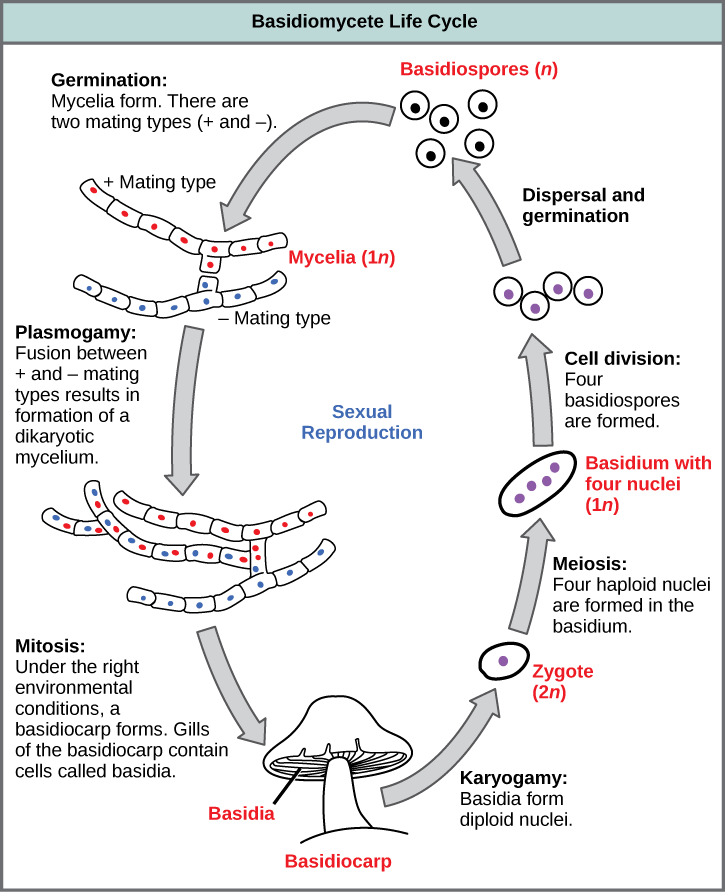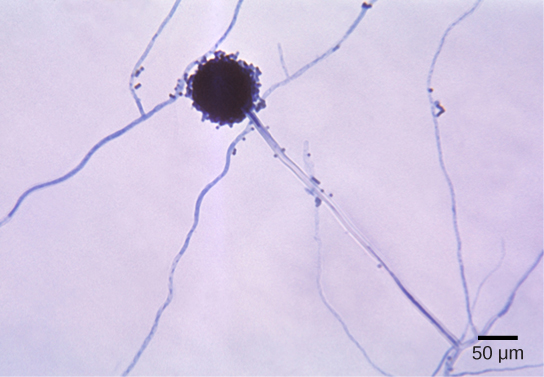| << Chapter < Page | Chapter >> Page > |

Which of the following statements is true?
Imperfect fungi—those that do not display a sexual phase—use to be classified in the form phylum Deuteromycota , , a classification group no longer used in the present, ever-developing classification of organisms. While Deuteromycota use to be a classification group, recent moleclular analysis has shown that the members classified in this group belong to the Ascomycota or the Basidiomycota classifications. Since they do not possess the sexual structures that are used to classify other fungi, they are less well described in comparison to other members. Most members live on land, with a few aquatic exceptions. They form visible mycelia with a fuzzy appearance and are commonly known as mold .
Reproduction of the fungi in this group is strictly asexual and occurs mostly by production of asexual conidiospores ( [link] ). Some hyphae may recombine and form heterokaryotic hyphae. Genetic recombination is known to take place between the different nuclei.

The fungi in this group have a large impact on everyday human life. The food industry relies on them for ripening some cheeses. The blue veins in Roquefort cheese and the white crust on Camembert are the result of fungal growth. The antibiotic penicillin was originally discovered on an overgrown Petri plate, on which a colony of Penicillium fungi killed the bacterial growth surrounding it. Other fungi in this group cause serious diseases, either directly as parasites (which infect both plants and humans), or as producers of potent toxic compounds, as seen in the aflatoxins released by fungi of the genus Aspergillus .
The Glomeromycota is a newly established phylum which comprises about 230 species that all live in close association with the roots of trees. Fossil records indicate that trees and their root symbionts share a long evolutionary history. It appears that all members of this family form arbuscular mycorrhizae : the hyphae interact with the root cells forming a mutually beneficial association where the plants supply the carbon source and energy in the form of carbohydrates to the fungus, and the fungus supplies essential minerals from the soil to the plant.
The glomeromycetes do not reproduce sexually and do not survive without the presence of plant roots. Although they have coenocytic hyphae like the zygomycetes, they do not form zygospores. DNA analysis shows that all glomeromycetes probably descended from a common ancestor, making them a monophyletic lineage.
Chytridiomycota (chytrids) are considered the most primitive group of fungi. They are mostly aquatic, and their gametes are the only fungal cells known to have flagella. They reproduce both sexually and asexually; the asexual spores are called zoospores. Zygomycota (conjugated fungi) produce non-septated hyphae with many nuclei. Their hyphae fuse during sexual reproduction to produce a zygospore in a zygosporangium. Ascomycota (sac fungi) form spores in sacs called asci during sexual reproduction. Asexual reproduction is their most common form of reproduction. Basidiomycota (club fungi) produce showy fruiting bodies that contain basidia in the form of clubs. Spores are stored in the basidia. Most familiar mushrooms belong to this division. Fungi that have no known sexual cycle were classified in the form phylum Deuteromycota, which the present classification puts in the phyla Ascomycota and Basidiomycota. Glomeromycota form tight associations (called mycorrhizae) with the roots of plants.
[link] Which of the following statements is true?
[link] A
[link] Which of the following statements is true?
[link] D

Notification Switch
Would you like to follow the 'Biology' conversation and receive update notifications?